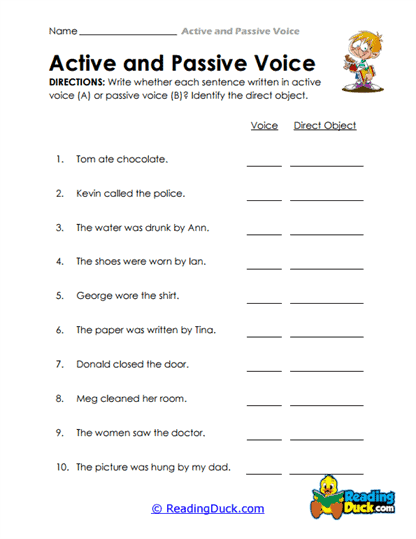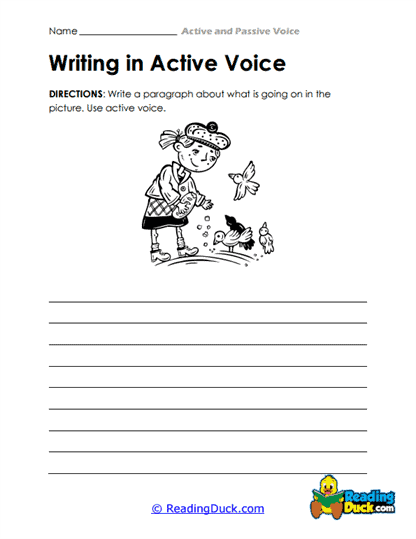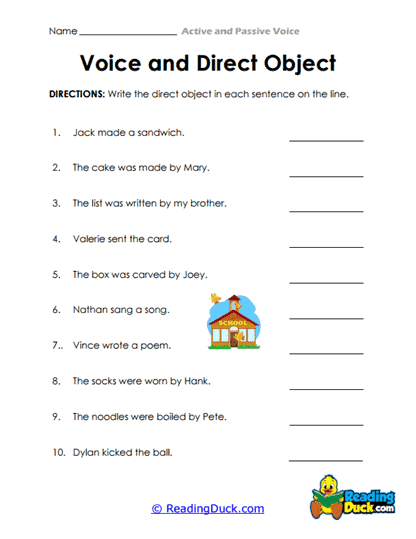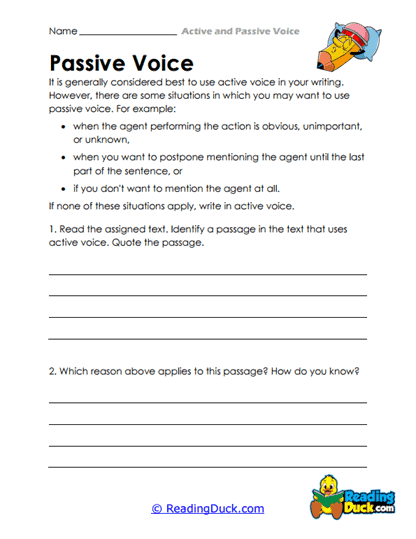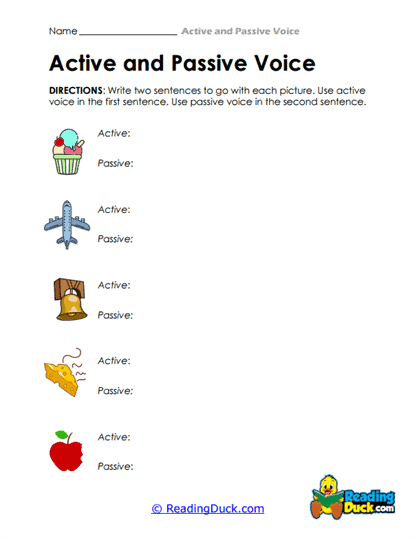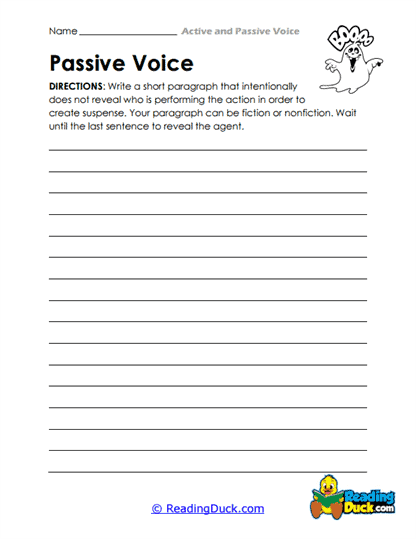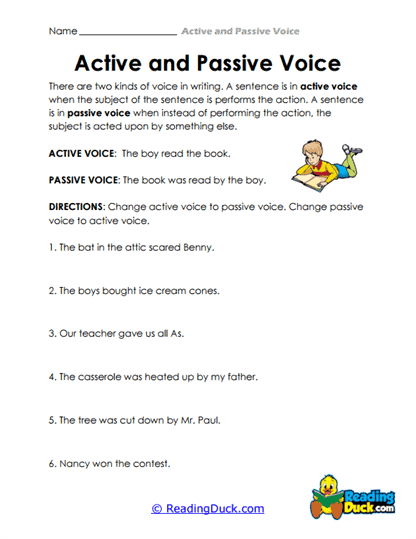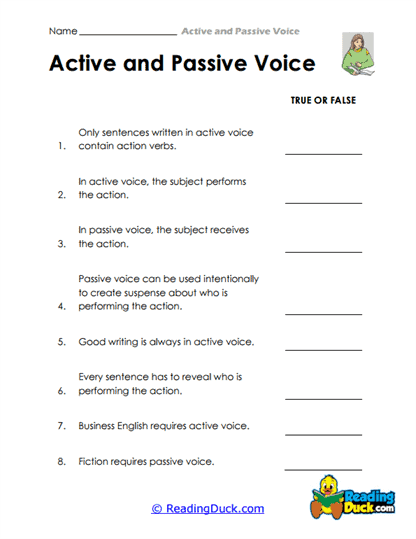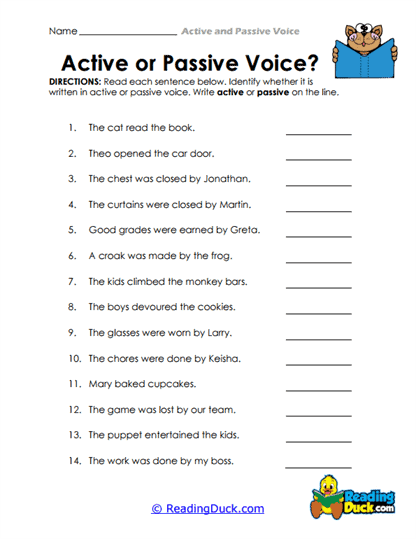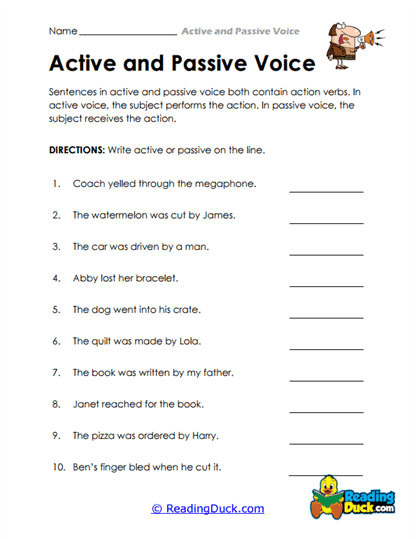Active and Passive Voice Worksheets
About Our Active and Passive Voice Worksheets
Our collection of worksheets on Active and Passive Voice provides educators, parents, and students with a robust toolset for mastering one of the most essential elements of grammar and writing. These worksheets fall under the Writing category within the Skills section and are meticulously designed to build a deeper understanding of the structural differences between active and passive voice, helping students refine their writing for clarity, purpose, and style.
Understanding the differences between active and passive voice is critical for students as they progress in their writing journey. Active voice, where the subject of the sentence performs the action, typically makes sentences more direct and engaging. In contrast, passive voice, where the action is performed on the subject, has its place in more formal or specific types of writing, such as scientific reports or when the doer of the action is unknown or irrelevant. Mastering both forms allows students to tailor their writing for various contexts, which is essential for both academic success and real-world communication.
This collection is designed to be adaptable, allowing it to fit seamlessly into different learning environments, whether in a traditional classroom, a homeschooling setting, or even for self-study. Each worksheet provides clear, focused exercises that encourage active learning, giving students the chance to apply their understanding of active and passive voice in practical and meaningful ways.
Understanding Active and Passive Voice
Before diving into our worksheets, it’s important to fully grasp what active and passive voice are and how they function in writing. Teaching active and passive voice is foundational because it teaches students how sentence structure influences the clarity, tone, and impact of their writing. The active voice emphasizes the subject performing an action, leading to more direct, vivid sentences. Here’s an example of a sentence written in active voice:
- The dog chased the ball.
In this sentence, the subject (“the dog”) is clearly performing the action of chasing. The sentence is direct, easy to understand, and engaging. Now, let's look at the same sentence in passive voice:
- The ball was chased by the dog.
Here, the action is being performed on the subject (“the ball”). The sentence is still grammatically correct, but it’s less direct and can sometimes make the writing feel more detached or formal.
While active voice is generally preferred for its clarity and energy, passive voice plays an important role in certain types of writing. For example, passive constructions are often used in scientific writing or formal reports, such as:
- The experiment was conducted to determine the results.
In this case, the focus is on the action (the experiment), rather than who performed it. It’s crucial for students to recognize when to use active or passive voice based on the context of their writing. Our worksheets aim to teach this skill in a progressive manner, ensuring students build a strong foundation before moving on to more complex sentence structures and nuanced usage.
How Our Worksheets Build Essential Writing Skills
The Active and Passive Voice Worksheets are designed to enhance students' overall writing abilities by helping them understand how sentence structure can affect clarity, engagement, and precision in communication. Each worksheet in this collection follows a step-by-step approach, starting with basic sentence identification and construction and gradually moving toward more complex writing tasks.
Some key skills these worksheets build include:
- Sentence Transformation: Students will practice transforming sentences from active to passive voice and vice versa, reinforcing their understanding of how word order and subject placement can shift a sentence’s emphasis.
- Identifying the Voice: Through exercises that require students to identify whether a sentence is in active or passive voice, students will sharpen their ability to recognize these structures quickly and efficiently.
- Contextual Usage: Worksheets include activities that focus on choosing the appropriate voice based on context, encouraging students to think critically about when and why they would use active or passive voice in their writing.
- Real-World Application: By incorporating examples from real-world writing, such as newspaper articles, reports, and fiction, students can see how both voices are used in practice, helping them to apply these concepts in their own writing.
These worksheets align with common educational standards, making them suitable for use in a variety of academic settings. They are also great for building writing skills for standardized tests, where students are often required to demonstrate a command of sentence structure and style.
Adaptability for Different Learning Environments
One of the greatest strengths of this worksheet collection is its adaptability. Whether you’re a teacher in a traditional classroom, a homeschooling parent, or a student working independently, these worksheets are designed to be flexible and user-friendly.
- Classroom Use: Educators can easily incorporate these worksheets into their lesson plans, either as part of direct instruction on sentence structure or as supplementary materials for students who need additional practice. These worksheets work well for individual work or can be used for group activities, allowing for collaborative learning.
- Homeschooling: Parents can use these worksheets as part of a larger writing curriculum or as standalone practice to ensure their children understand how to use active and passive voice effectively. The clear instructions and examples make it easy for parents to guide their children through the exercises without needing specialized teaching experience.
- Self-Study: Students who are looking to improve their writing independently can use these worksheets as a resource for self-directed learning. The worksheets provide immediate feedback through answer keys, allowing learners to monitor their progress and identify areas where they may need additional practice.
In each of these environments, the worksheets offer enough flexibility to support different learning styles, from visual learners who benefit from clear examples and diagrams, to kinesthetic learners who might prefer hands-on activities and sentence manipulation tasks.
Supporting Differentiated Instruction
Every classroom is filled with students who have unique learning needs, and our Active and Passive Voice Worksheets are designed to support differentiated instruction. Teachers can easily modify or extend the exercises to meet the varying abilities of their students, ensuring all learners can engage with the material at a level that suits them.
- For Struggling Learners: Teachers can provide more guided practice for students who need additional support. Worksheets with simpler sentence structures and more repetition can help these students gain confidence in their ability to identify and use active and passive voice.
- For Advanced Learners: For students who are ready for a challenge, more complex worksheets offer opportunities to analyze nuanced uses of passive voice or transform longer, multi-clause sentences. Teachers can also introduce creative writing assignments where students must consciously choose between active and passive voice to create specific effects in their writing.
This adaptability ensures that the worksheets remain useful for a diverse range of learners, making them an invaluable resource for any teacher looking to support all students in their writing development.
Integrating into Lesson Plans and Extending Learning
These worksheets are ideal for use as supplemental material in writing lessons, whether you're introducing the topic of active and passive voice or reviewing it before an assessment. Teachers can easily incorporate these worksheets into a variety of lesson plans, using them for individual practice, homework, or group activities.
- Group Work: Assigning these worksheets as part of group work encourages students to collaborate on identifying sentence structure and discussing why a particular voice might be more appropriate in different contexts. Group discussions around this topic can foster deeper understanding and help students develop their critical thinking skills.
- Creative Extensions: To extend the learning from these worksheets, teachers might ask students to rewrite a short story or essay, transforming it from active to passive voice or vice versa. Alternatively, students could research a specific topic and write a report using both active and passive voice intentionally, to practice choosing the right voice based on context.
These additional activities help deepen students’ understanding of sentence structure and ensure they can apply what they've learned to broader writing projects.
Our collection of Active and Passive Voice Worksheets offers a comprehensive, flexible, and engaging way to improve students’ writing skills. With a variety of exercises and applications, these worksheets are an invaluable resource for educators, parents, and students alike.
